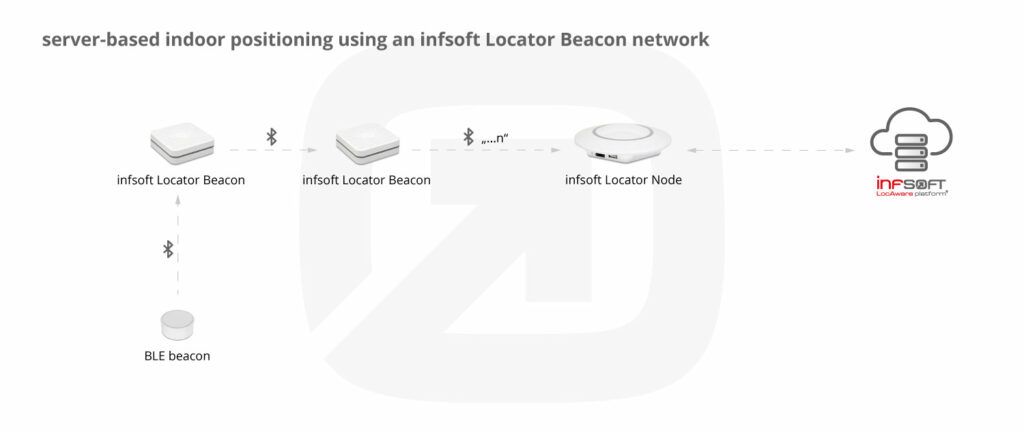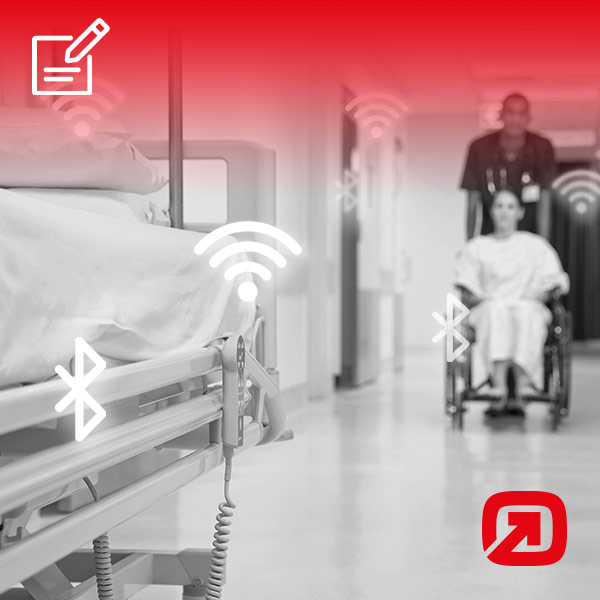There are several options available for implementing an RTLS (Real-Time Locating System) in a hospital. Under certain circumstances, the existing Wi-Fi infrastructure can be used. But also the acquisition of a complete solution from one provider offers many advantages. Following, we will discuss different approaches for indoor positioning in hospitals in more detail.
POSITIONING BASED ON AN EXISTING INFRASTRUCTURE
Under certain circumstances, the hospital’s existing Wi-Fi infrastructure can be used to set up an indoor positioning system. In this context, a distinction must be made between which technologies are supported by the infrastructure provider with regard to the access points in use, but also the associated location engine.
Wi-Fi Positioning
In order to realize Wi-Fi tracking, Wi-Fi tags are attached to the assets to be tracked or worn by employees or patients in the form of wristbands. In this scenario, there are two options for positioning:
1) smart Wi-Fi tags
2) smart access points with location engine
In setup number 1, the Wi-Fi tags act as a client. In this case, the tag receives signals from several Wi-Fi access points in the building and sends the information via Wi-Fi to a back end. The position of the tag is determined based on the measured signal strength to the various access points. In this approach, the logic for calculating the position is mapped on the tag or in the connected back end. The existing Wi-Fi infrastructure only serves as a signal transmitter and there is no need for any special configuration of the access points nor is a separate engine from the access point provider required.
In setup number 2, the logic mapping is done at access point level and in the location engine of the infrastructure provider. The access points receive the signals emitted by a simple Wi-Fi tag and make the data available to the location engine in order to calculate the position. Via an interface, the calculated data can then be retrieved by third-party providers and used further.
In most cases, however, the existing Wi-Fi infrastructure in the hospital is not sufficient to implement reliable positioning at room level. Both the necessary investment in infrastructure extensions (supported access points in each room, location engine of the access point provider, e.g. Cisco DNA Spaces) and the Wi-Fi tags are cost-intensive. Additional disadvantages of a Wi-Fi positioning system are the comparatively low battery life and the size of Wi-Fi tags as well as the sometimes great inaccuracy of the positioning.
Bluetooth Low Energy Positioning
Some access point providers allow the localization of Bluetooth Low Energy (BLE) beacons in addition to Wi-Fi positioning. However, the problem here is that the corresponding access point infrastructures are typically installed and optimized for data communication, so that room-accurate positioning with existing infrastructure is not possible. Furthermore, the providers sometimes pursue concepts of a closed ecosystem, in which either only specifically certified beacons can be used in their full functional scope (evaluation of battery status, sensor information, etc.) or beacons from third-party manufacturers are used and limited to the transmission of position recognition.

COMPLETE SOLUTION FROM INFSOFT
infsoft follows an agnostic approach to positioning in the infsoft LocAware platform® and by means of infsoft Locator Nodes and infsoft Locator Beacons. Thus, depending on the application, different technologies can be used (even simultaneously). In addition to Wi-Fi, Bluetooth Low Energy (BLE) and Ultra-wideband (UWB), infrared based solutions or RFID technologies are also available.
Wi-Fi Positioning
Also Wi-Fi positioning using infsoft Locator Nodes (receive signals of the Wi-Fi tags and send the data to the back end) is often not the best solution in a hospital environment, because the basic problems for positioning via Wi-Fi (battery life and costs of the tags, comparatively inaccurate position resolution) remain. Although infsoft Locator Nodes are inexpensive compared to access point solutions, they also need to be installed in the building in higher density for this application and require a constant power supply and network connection.
Bluetooth Low Energy Positioning
A more reliable and cheaper alternative is an indoor positioning system based on Bluetooth Low Energy beacons. With BLE beacons, room-accurate positioning can be achieved with moderate installation effort.
BLE beacons are attached to the assets to be tracked while infsoft Locator Beacons are mounted on the ceilings throughout the building. The Locator Beacons receive the signals of the mobile beacons and forward them to an infsoft Locator Node. The latter sends the data to the back end where the position of the assets is determined.
Since all hardware components, except for one Locator Node per floor, are battery powered, installation is possible with comparatively little effort. The beacons and Locator Beacons have a battery life of several years, since a position update every few minutes is sufficient for most use cases. For real-time locating requirements, infsoft Locator Nodes can also be used at any time.

CONCLUSION
All in all, an RTLS with beacons is more cost-effective compared to Wi-Fi, in terms of both installation and operation, while at the same time enabling more accurate positioning. In addition, infsoft solutions are compatible with the beacons of all manufacturers and the enrichment of the position data with sensor data (temperature, CO2 etc.) is also possible without any problems when using sensor beacons.
For more information please contact us or take a look at our healthcare white paper.







